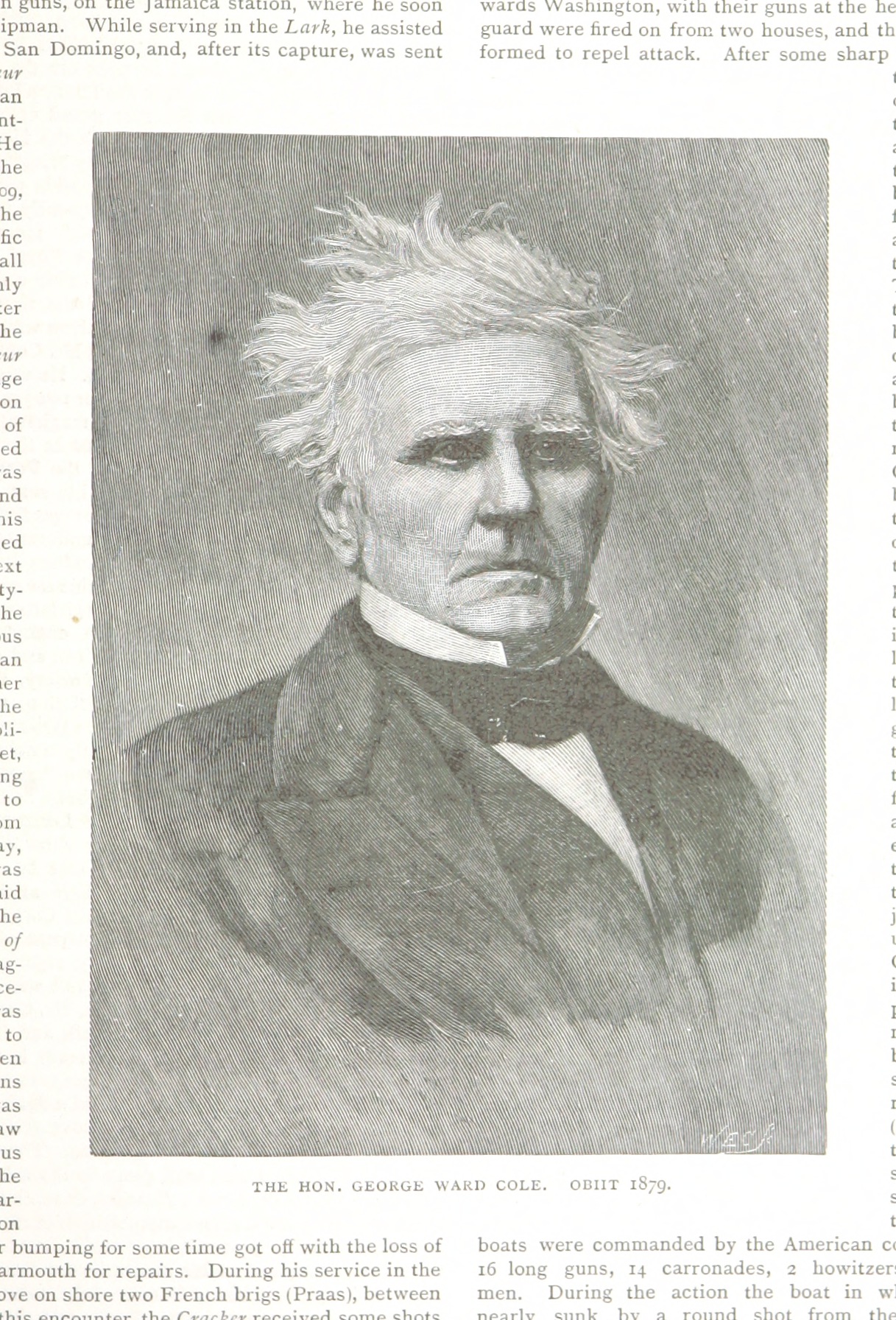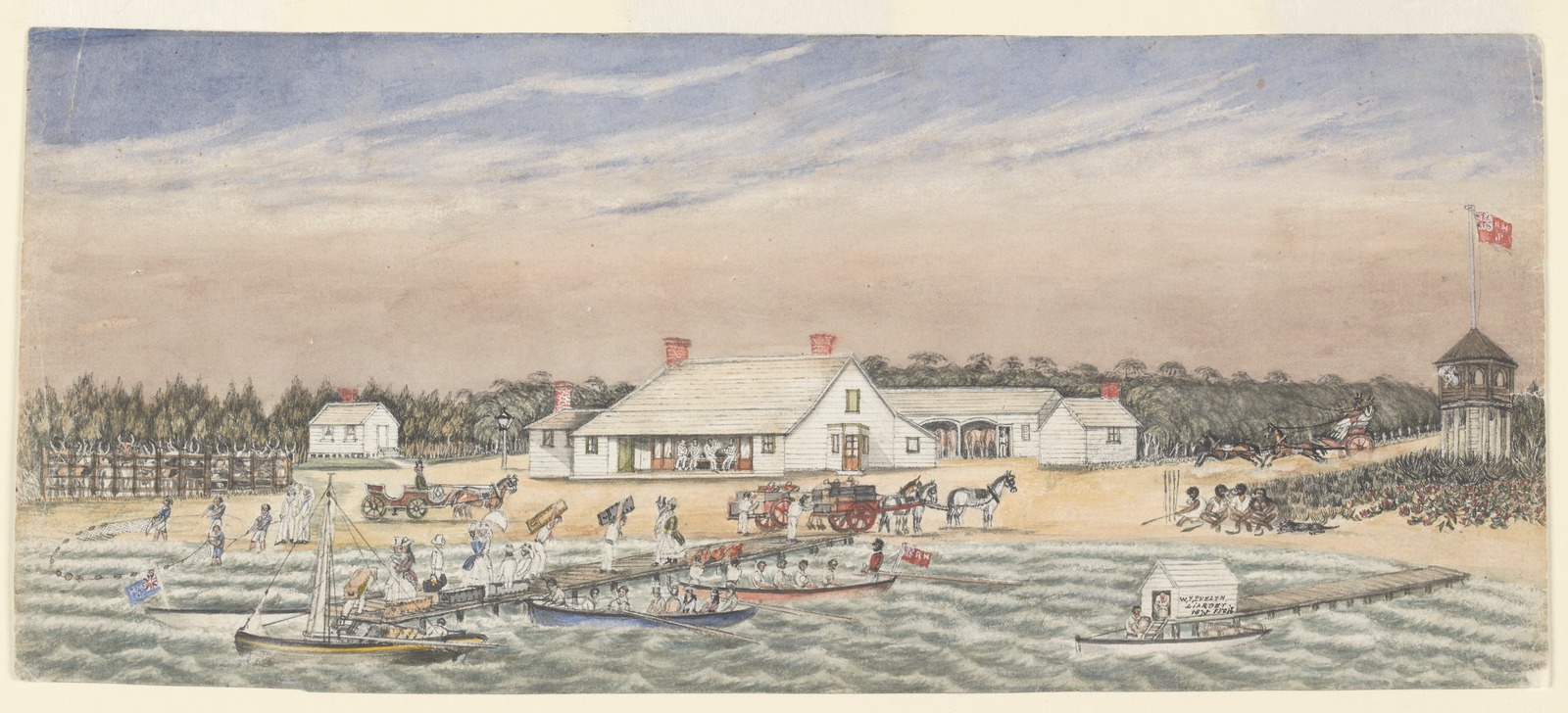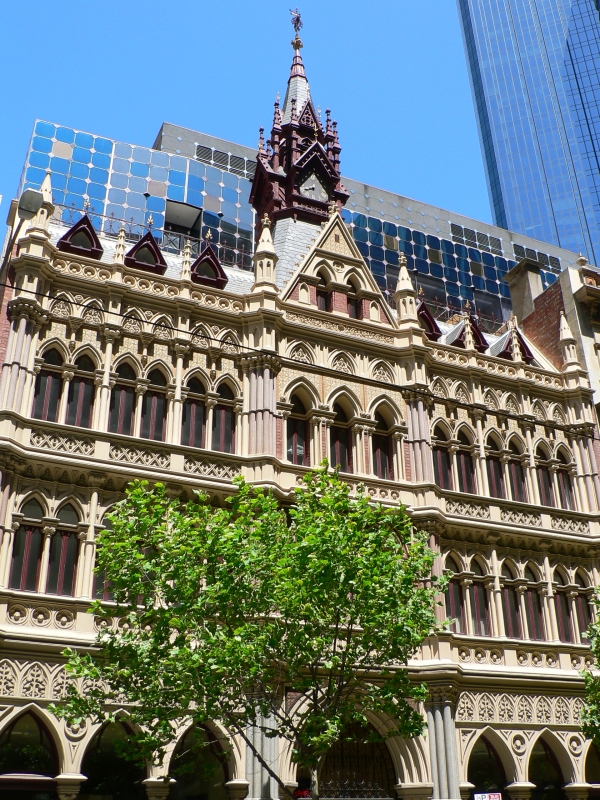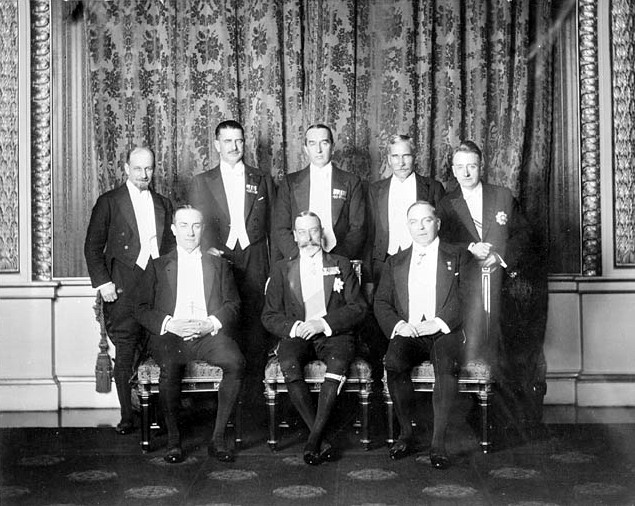|
James Lorimer (Australian Politician)
Sir James Lorimer (30 March 1831 – 6 September 1889) was an Australian politician and businessman. He was the first chairman of the Melbourne Harbor Trust and a Member of the Legislative Council in the Victorian parliament from 1879 to 1889. Personal life Lorimer was born on 30 March 1831 in Dumfriesshire, Scotland, to merchant Thomas Lorimer and Catherine, née Walkin. He was educated at Haddon Hall Academy, and articled to a Liverpool softgoods firm which traded with Africa and America. He travelled to Victoria in 1853 on health advice and chose to stay. He married Eliza Kenworthy, the daughter of the United States consul in Sydney, on 4 March 1858, with whom he raised eleven children, ten of whom survived him. In 1869 he commissioned architect Leonard Terry to design a large Toorak mansion which he named 'Greenwich House'. He died of pleurisy on 6 September 1889, leaving an estate of £60,000, and was buried in St Kilda Cemetery. Business interests Lorimer founded a ... [...More Info...] [...Related Items...] OR: [Wikipedia] [Google] [Baidu] |
Duncan Gillies
Duncan Gillies (14 January 1834 – 12 September 1903), was an Australian colonial politician who served as the 14th Premier of Victoria. Gillies was born at Overnewton near Glasgow, Scotland, where his father had a market garden. He was sent to the high school until he was about 14, when he entered an office in Glasgow. In 1852, he arrived in Melbourne and travelled to the goldfields at Ballarat, where he worked first as a miner and later as a businessman and company director. Gillies was elected to the Victorian Legislative Assembly for Ballarat West in 1861, holding that seat until 1868. A conservative, he was President of the Board of Lands and Works in the short-lived government of Charles Sladen in 1868, which cost him his seat at Ballarat, a strongly liberal constituency. He was elected for Maryborough 1870–77, Rodney 1877–89, Eastern Suburbs 1889–94 and Toorak 1897–1903. He was Commissioner for Railways and Roads in the ministries of James Francis and George ... [...More Info...] [...Related Items...] OR: [Wikipedia] [Google] [Baidu] |
Graham Berry
Sir Graham Berry, (28 August 1822 – 25 January 1904), Australian colonial politician, was the 11th Premier of Victoria. He was one of the most radical and colourful figures in the politics of colonial Victoria, and made the most determined efforts to break the power of the Victorian Legislative Council, the stronghold of the landowning class. Early years Berry was born in Twickenham, near London, where his father, Benjamin Berry, was a licensed victualler. He had a primary education until 11 years old, then became an apprentice draper. In 1848 he married Harriet Ann Blencowe, with whom he had eleven children. Migration In 1852 he migrated to Victoria Victoria most commonly refers to: * Victoria (Australia), a state of the Commonwealth of Australia * Victoria, British Columbia, provincial capital of British Columbia, Canada * Victoria (mythology), Roman goddess of Victory * Victoria, Seychelle ..., and went into business as a grocer in Prahran, Victoria, Prahran, then a ... [...More Info...] [...Related Items...] OR: [Wikipedia] [Google] [Baidu] |
George Ward Cole
George Ward Cole F.R.G.S., Commander R.N. (15 November 1793 – 26 April 1879) was a Royal Navy officer and politician in Australia, member of the Victorian Legislative Council. Cole was the fourth son of John Cole, of Durham, and was born at Lumley Castle, in that county. He entered the Royal Navy in October 1807, and served with distinction in various parts of the world, being on several occasions severely wounded. Having been placed on half-pay in October. 1817, Captain Cole went into the merchant service, and commanded several vessels of which he was part owner. After numerous adventurous voyages, and engaging in various speculations, Captain Cole in 1839 decided to settle in Sydney, and purchased land there; but, after a visit to England, he changed his intention, and made his home in Victoria where he arrived in July 1840, and started business in Melbourne. In the following year he purchased land on the Yarra River, and constructed the well-known Cole's Wharf in Flinders St ... [...More Info...] [...Related Items...] OR: [Wikipedia] [Google] [Baidu] |
Yarra River
The Yarra River or historically, the Yarra Yarra River, (Kulin languages: ''Berrern'', ''Birr-arrung'', ''Bay-ray-rung'', ''Birarang'', ''Birrarung'', and ''Wongete'') is a perennial river in south-central Victoria, Australia. The lower stretches of the Yarra are where Victoria's state capital Melbourne was established in 1835, and today metropolitan Greater Melbourne dominates and influences the landscape of its lower reaches. From its source in the Yarra Ranges, it flows west through the Yarra Valley which opens out into plains as it winds its way through Greater Melbourne before emptying into Hobsons Bay in northernmost Port Phillip Bay. The river has been a major food source and meeting place for Indigenous Australians for thousands of years. Shortly after the arrival of European settlers, land clearing forced the remaining Wurundjeri people into neighbouring territories and away from the river. Originally called ''Birrarung'' by the Wurundjeri, the current name was mis ... [...More Info...] [...Related Items...] OR: [Wikipedia] [Google] [Baidu] |
Port Melbourne
Port Melbourne is an inner-city suburb in Melbourne, Victoria, Australia, south-west of Melbourne's Central Business District, located within the Cities of Melbourne and Port Phillip local government areas. Port Melbourne recorded a population of 17,633 at the 2021 census. The area to the north of the West Gate Freeway is located within the City of Melbourne, with The area to the south located within the City of Port Phillip. The suburb is bordered by the shores of Hobsons Bay and the lower reaches of the Yarra River. Port Melbourne covers a large area, which includes the distinct localities of Fishermans Bend, Garden City and Beacon Cove. Historically it was known as Sandridge and developed as the city's second port, linked to the nearby Melbourne CBD. The formerly industrial Port Melbourne has been subject to intense urban renewal over the past three decades. As a result, Port Melbourne is a diverse and historic area, featuring industrial and port areas along the Yarra, ... [...More Info...] [...Related Items...] OR: [Wikipedia] [Google] [Baidu] |
Australian Church
The Australian Church (1884–1957) was founded by Dr. Charles Strong in Melbourne."Australian Church - Institution" (overview) ''Reason in Revolt Project'', 2006-11-15, ''ReasoninRevolt.net.au'' Charles Strong was a minister who, previously, had been charged with because of his liberal . The ''Australian Church'' had a firm commitment to |
Presbyterian Church Of Victoria
The Presbyterian Church of Victoria is one of the constituent churches of the Presbyterian Church of Australia. It was established in 1859 as a union of Church of Scotland, Free Presbyterian and United Presbyterian congregations. The Presbyterian Church of Victoria in the nineteenth century has been described as "the strongest, wealthiest, loudest and most influential of the churches in Victoria." In 1901, it united with the Presbyterian churches of the other states of Australia to form the Presbyterian Church of Australia. From 1901 to 1977, the PCV was the largest of the state Presbyterian churches. In 1977, the majority of congregations left to join the Uniting Church in Australia. The Presbyterian Church of Victoria accepts the Westminster Confession of Faith as its subordinate standard, read in the light of a Declaratory Statement of 1901. It also subscribes to the "general principles" of the Larger and Shorter Catechisms, the Form of Presbyterial Church Government, the ... [...More Info...] [...Related Items...] OR: [Wikipedia] [Google] [Baidu] |
Charles Strong
Charles Strong (26 September 1844 – 12 February 1942) was a Scottish-born Australian preacher and first minister of the Australian Church. Early life Strong was the third son of the Rev. David Strong and Margaret Paterson, ''née'' Roxburgh, and was born at Dailly, Ayrshire, Scotland. Strong was educated at the Ayr Academy, Glasgow Academy, and in Arts and Divinity at the University of Glasgow 1859–67 (hon. LL.D., 1887). John Caird had become Professor of Divinity in 1863 and was the principal influence on Strong. Caird was known as an attractive preacher but his theology was much influenced by G.W.H. Hegel, the German idealist philosopher. After some months experience as a private tutor 1867, Strong was licensed as a preacher on 2 October 1867 and became an assistant at Dalmellington, Ayrshire. On 7 October 1868 he was ordained to the Old North Kirk at Greenock which was then a chapel under the oversight of the Old West Kirk. On 16 March 1871 he was inducted to Anderston ... [...More Info...] [...Related Items...] OR: [Wikipedia] [Google] [Baidu] |
Scots' Church, Melbourne
The Scots' Church is a Presbyterian church in Melbourne, Victoria, Australia. It was the first Presbyterian church to be built in the Port Phillip District (now the state of Victoria) and is located on Collins Street. It is a congregation of the Presbyterian Church of Australia and has been described as "an icon for well over a hundred years". Background The Reverend James Forbes was recruited to come to Australia as a Presbyterian minister by the Revd John Dunmore Lang, arriving in Melbourne from Sydney via boat on 20 January 1838. He found that a retired Church of Scotland minister, the Revd James Clow, had arrived on 25 December 1837 and had commenced an afternoon service from 2 pm and 4 pm according to Presbyterian forms in a basic building constructed west of William Street and north of Little Collins Street (now the site of the AMP centre). Clow had been a Church of Scotland chaplain in Bombay, India but had retired and was of independent means. He had intended to settle ... [...More Info...] [...Related Items...] OR: [Wikipedia] [Google] [Baidu] |
Alfred Deakin
Alfred Deakin (3 August 1856 – 7 October 1919) was an Australian politician who served as the second Prime Minister of Australia. He was a leader of the movement for Federation, which occurred in 1901. During his three terms as prime minister over the subsequent decade (1903–1904, 1905–1908, 1909–1910), he played a key role in establishing national institutions. Deakin was born in Melbourne to middle-class parents. He was elected to the Victorian Legislative Assembly in 1879, aged 23, additionally working as a barrister and journalist. He held ministerial office sporadically beginning in 1883, serving twice as Attorney-General of Victoria and aligning himself with liberal and radical reformers. In the 1890s Deakin became one of the leading figures in the movement for the federation of the Australian colonies. He was a delegate to the federal conventions and served on the committees that drafted the federal constitution. He later campaigned at a series of referendums ... [...More Info...] [...Related Items...] OR: [Wikipedia] [Google] [Baidu] |
Imperial Conference
Imperial Conferences (Colonial Conferences before 1907) were periodic gatherings of government leaders from the self-governing colonies and dominions of the British Empire between 1887 and 1937, before the establishment of regular Meetings of Commonwealth Prime Ministers in 1944. They were held in 1887, 1894, 1897, 1902, 1907, 1911, 1921, 1923, 1926, 1930, 1932 and 1937. All the conferences were held in London, the seat of the Empire, except for the 1894 and 1932 conferences which were held in Ottawa, the capital of the senior Dominion of the Crown. The 1907 conference changed the name of the meetings to Imperial Conferences and agreed that the meetings should henceforth be regular rather than taking place while overseas statesmen were visiting London for royal occasions (e.g. jubilees and coronations). List of conferences Notable meetings Originally instituted to emphasise imperial unity, as time went on, the conferences became a key forum for dominion gov ... [...More Info...] [...Related Items...] OR: [Wikipedia] [Google] [Baidu] |
Order Of St Michael And St George
The Most Distinguished Order of Saint Michael and Saint George is a British order of chivalry founded on 28 April 1818 by George IV, George IV, Prince of Wales, while he was acting as prince regent for his father, George III, King George III. It is named in honour of two military saints, Michael (archangel), Michael and Saint George, George. The Order of St Michael and St George was originally awarded to those holding commands or high position in the Mediterranean Sea, Mediterranean territories acquired in the Napoleonic Wars, and was subsequently extended to holders of similar office or position in other territories of the British Empire. It is at present awarded to men and women who hold high office or who render extraordinary or important non-military service to the United Kingdom in a foreign country, and can also be conferred for important or loyal service in relation to foreign and Commonwealth of Nations, Commonwealth affairs. Description The Order includes three class ... [...More Info...] [...Related Items...] OR: [Wikipedia] [Google] [Baidu] |






